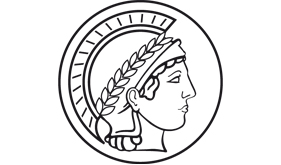10.1 Introduction
Gordion
A great number of the Phrygian
10.2 Phrygian Belts
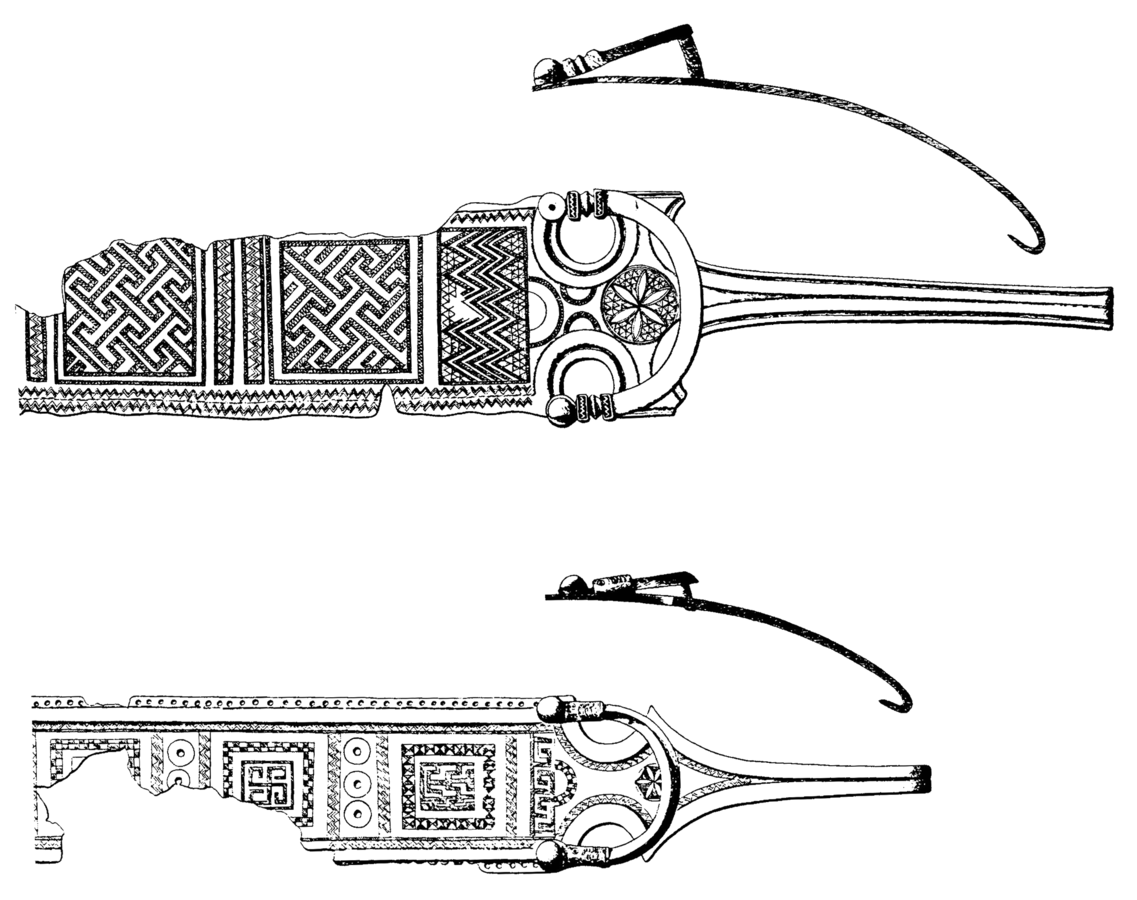
Fig. 10.1: Two bronze
Probably the most exquisite belts
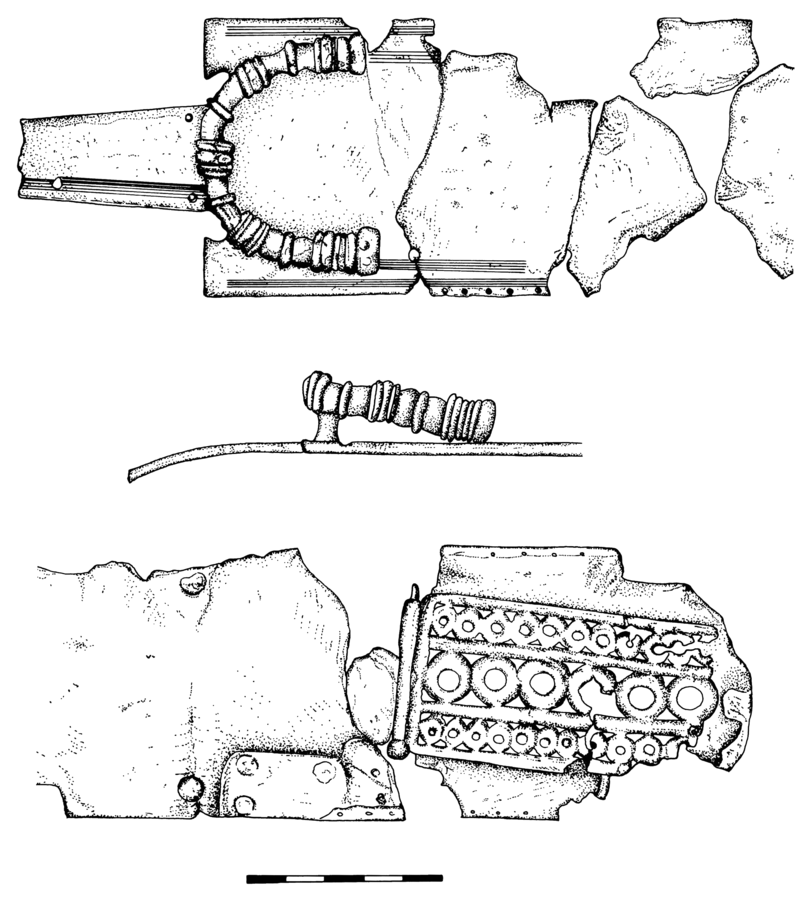
Fig. 10.2: Bronze
These belts
Another type of belt, which will not be discussed here, was found in the so-called “Midas
10.3 Visual Representations of Belts. Parallels
Some analogies of the Phrygian
Although a genetic relation of these belts
The Near Eastern belts
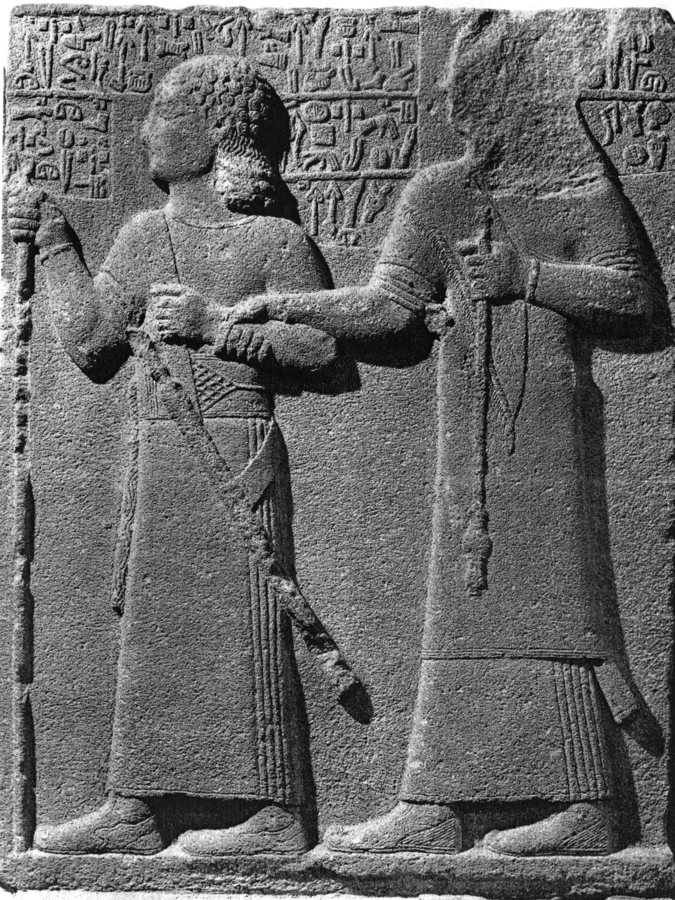
Fig. 10.3: The Carchemish
10.4 Belts and Fibulae Dedicated at Greek Sanctuaries
Besides vessels, cauldrons and phialae, Phrygian

Fig. 10.4: Bronze
In mainland Greece
Phrygian
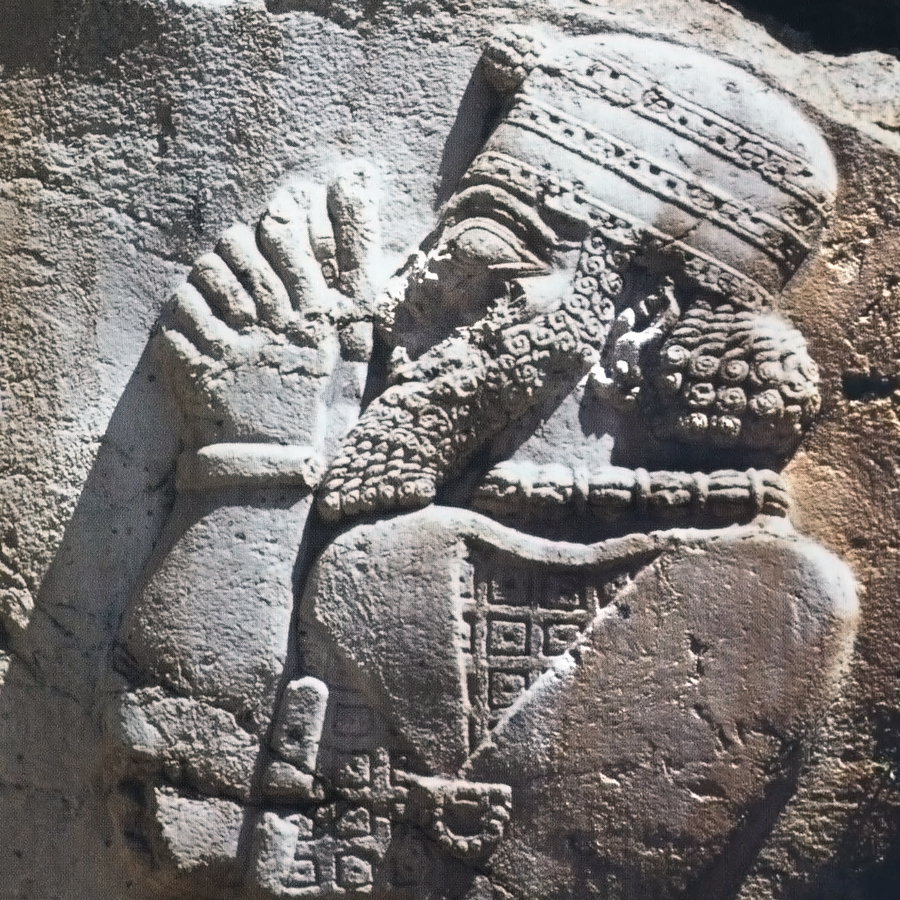
Fig. 10.5: Detail from the Ivriz
Phrygian

(Caner 1983, No. 1070)
Fig. 10.6: Double-pin fibula from Tumulus MM (Gordion
(Caner 1983, No. 1070)
These highly decorative dress accessories probably gave rise to Greek imitations of fibulae
Following the development of the Phrygian belts
The peak of dedications of Phrygian belts
Sometimes it is difficult to distinguish the Greek imitations from the Phrygian
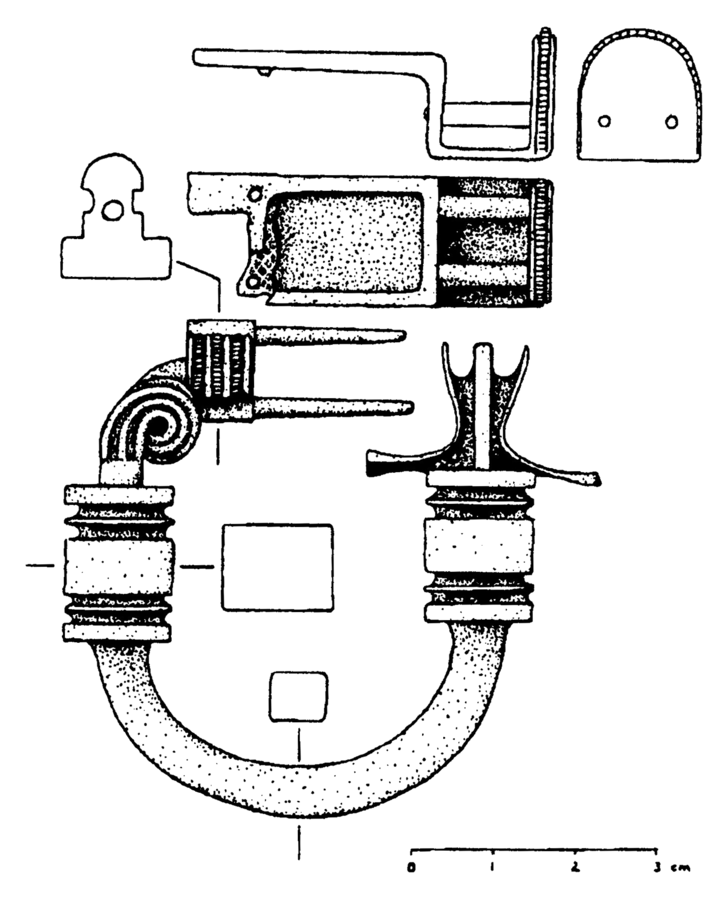
Fig. 10.7: Double-pin fibula from Samos
It is generally agreed that the east Greek workshops were responsible for the spread of most of the Phrygian
10.5 Purpose and Symbolism
Most of the Phrygian belts
It is known from literary sources and epigraphic
The evidence from the Phrygian burials suggests that the belts
Similarities between the geometric decorative designs on some of the belts
I would suggest that the bronze
The choice of Phrygian objects, imports or imitations, strongly suggest a relation with a goddess of rather Anatolian
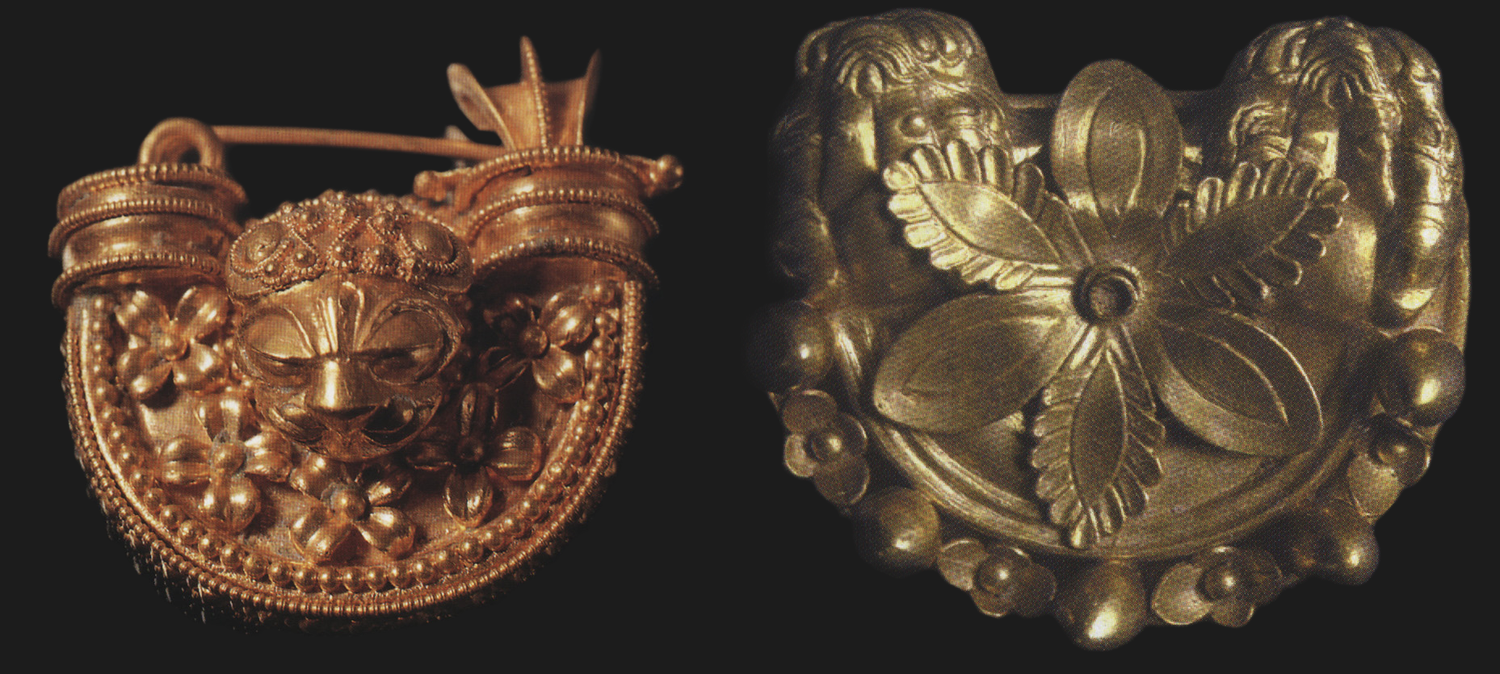
Fig. 10.8: Two gold fibulae
In mainland Greece
10.6 Conclusions
The above observations show that belts
Bibliography
Akurgal, E. (1949). Späthethitische Bildkunst. Ankara: Archaeologisches Institut der Universität Ankara.
- (1993). Eski çağda Ege ve İzmir..
Bammer, A. (1991/1992). Multikulturelle Aspekte der frühen Kunst in Artemision von Ephesos. ÖJh 61: 17-54
- (2005). Der Peripteros im Artemision von Ephesos. Anatolia Antiqua 13: 177-221
Bammer, A., U. Muss (1996). Das Artemision von Ephesos. Das Weltwunder Ioniens in archaischer und klassischer Zeit. Darmstadt: Philipp von Zabern.
- (2006). Ein Felsdenkmal auf dem Bülbüldağ von Ephesos. Anatolia Antiqua 14: 65-69
Bennett, M.J. (1997). Belted Heroes and Bound Women. The Myth of the Homeric Warrior-King..
Bilgi, Ö. (2004). Anatolia: Cradle of Castings..
Bischop, D. (1996). Fibeln der archaischen bis römischen Zeit in Assos. Asia Minor Studien 21: 139-65
- (2006). Gefässe aus Metall. Asia Minor Studien 57: 215-226
Blinkenberg, C. (1931). Lindos: Fouilles de l'Acropole 1902–1914. 1. Les petits objets. Berlin: Walter de Gruyter.
Boardman, J. (1959). Chian and Early Ionic Architecture. The Antiquaries Journal 39(3–4): 170-2118
- (1961/1962). Ionian Bronze Belts. Anatolia 6: 179-189
- (1966). An Anatolian Greek Belt Handle. AnatSt 16: 193-194
- (1967). Excavations in Chios 1952–1955. Greek Emporio. BSA Suppl.
- (1999). The Greeks Overseas. Their Early Colonies and Trade. London: ThamesHudson.
Boehlau, J., E. Habich (1996). Samos—die Kasseler Grabungen 1894 in der Nekropole der archaischen Stadt. Kassel: Staatliche Museen Kassel.
Boehlau, J., K. Schefold (1942). Larisa am Hermos 1902–34, 3: Die Kleinfunde. Berlin: Walter de Gruyter.
Boehmer, R.M. (1973). Phrygische Prunkgewänder des 8. Jahrhunderts v. Chr. Herkunft und Export. AA 2: 149-172
Buluç, S. (1988). The Architectural Use of the Animal and Kybele Reliefs Found in Ankara and its Vicinity. Source 7 3/4: 16-23
Calmeyer, P. (1971). Gürtel. Reallexikon der Assyriologie und Vorderasiatischen Archäologie 3: 689-693
Caner, E. (1983). Fibeln in Anatolien I. Prähistorische Bronzefunde 14.8.. München: C.H. Beck.
Dawkins, R.M. (1929). The Sanctuary of Artemis Orthia at Sparta. New York: Macmillan.
DeVries, K. (2005). Greek Pottery and Gordion Chronology. In: The Archaeology of Midas and the Phrygians: Recent Work at Gordion Ed. by L. Kealhover. Philadelphias: University of Pennsylvania Museum of ArchaeologyAnthropology 36-55
Donder, H. (2002). Funde aus Milet. XI. Die Metallfunde. AA 1: 1-8
Ebbinghaus, S. (2006). Begegnungen mit Ägypten und Vorderasien im archaischen Heraheiligtum von Samos. In: Stranieri e non cittadini nei santuari greci. Atti del convegno internationale Ed. by A. Naso. 187-229
Günter, W. (1988). “Vieux et inutilisable” dans un inventaire inédit de Milet. In: Comptes et inventaires dans la cité grecque. Actes du colloque international d'épigraphie tenu à Neuchâtel du 23 au 26 septembre 1986 en l'honneure de Jacques Tréheux Ed. by P. Knoepfler, N. Quellet. Neuchâtel: Université de Neuchâtel, Faculté des lettres 215-237
Hawkins, J.D. (1997). Mita. Reallexikon der Assyriologie und Vorderasiatischen Archäologie 8: 271-273
- (2000). Corpus of Hieroglyphic Luwian Inscriptions. Volume I Inscriptions of the Iron Age. Part 1: Text, Introduction, Karatepe, Karkamiš, Tell Ahmar, Maraş, Malatya, Commagene. Berlin: de Gruyter.
Hogarth, D. G. (1908). Excavations at Ephesus. London: British Museum.
Hogarth, D.G. (1914). Carchemish I. Introductory. London: British Museum.
Hrouda, B. (1965). Die Kulturgeschichte des assyrischen Flachbildes. Bonn: Habelt.
Işık, F. (2001). Elfenbeinfiguren aus dem Artemision von Ephesos. In: Der Kosmos der Artemis von Ephesos Ed. by U. Muss. Vienna: Österreichisches Archäologisches Institut 85-100
- (2008). Die anatolisch-altphrygische Muttergottheit vom Neolithikum bis zur Klassik. Asia Minor Studien 61: 33-68
Jantzen, U. (1972). Aegyptische und orientalische Bronzen aus dem Heraion von Samos. Samos VIII. Bonn: Rudolf Habelt.
Kilian, K. (1975). Fibeln in Thessalien von der mykenischen bis zur archaischen Zeit. Prähistorische Bronzefunde XIV, 2. München: C.H. Beck.
Klebinder, G. (2001). Bronzegürtel aus dem Artemision von Ephesos. In: Der Kosmos der Artemis von Ephesos Ed. by U. Muss. Wien: Österreichisches Archäologisches Institut 111-122
- (2002). Ephesos und Phrygien. Eine Untersuchung der Beziehungen anhand der Bronzen aus dem frühen Artemision von Ephesos. In: Temenos. Festgabe für Florens Felten und Stefan Hiller Ed. by B. Asamer, P. Höglinger, P. H., Reinhold P., R. P.. Wien: Phoibos 75-82
Klebinder-Gauß, G. (2007). Bronzefunde aus dem Artemision von Ephesos. Wien: Verlag der Österreichischen Akademie der Wissenschaften.
Kohler, E. (1995). The Lesser Phrygian Tumuli. Part 1. The Inhumations. The Gordion Excavations, 1950–1973 Final Reports. 2. Philadelphia: The University of Pennsylvania Museum.
Lamb, W. (1934–1935). Excavations at Kato Phaná in Chios. BSA 35: 138-164
Losfeld, G. (1991). Essai sur le costume grec. Paris: De Boccard.
Luschan, F. (1902). Ausgrabungen in Sendschirli. 3. Berlin: Orient-Comité.
Mallwitz, A. (1999). Ergebnisse und Folgerungen. Zur Steinzeilenschicht. In: XI. Bericht über die Ausgrabungen in Olympia 1977–1981 Berlin: Walter de Gruyter
Mellink, M.J. (1990). Archaeology in Anatolia. AJA 94: 125-151
Moorey, P.R.S. (1967). Some Ancient Metal Belts: Their Antecedants and Relatives. Iran 5: 83-98
Morris, S.P. (2001a). Potnia Aswiya: Anatolian Contributions to Greek Religion. In: Potnia Deities and Religion in the Aegean Bronze Age. Proceedings of the 8th International Aegean Conference, Göteborg, Göteborg University, 12-15 April 2000 (Aegaeum 22) (Université de Liège, University of Texas at Austin) Ed. by R. Laffineur, R. Hägg. Liège: Universite de Liège 423-34
- (2001b). The Prehistoric Background of Artemis Ephesia: A Solution to the Enigma of Her `Breasts'?. In: Der Kosmos der Artemis von Ephesos. Österreichisches Archäologisches Institut. Sonderschriften Bd. 37 Ed. by U. Muss. Vienna: Österreichisches Archäologisches Institut 135-151
Munn, M. (2006). The Mother of the Gods, Athens, and the Tyranny of Asia. A Study of Sovereignty in Ancient Religion. Berkeley: University of California Press.
Muscarella, O.W. (1967a). Fibulae Represented on Sculpture. Journal of Near Eastern Studies 26(2): 82-86
- (1967b). Phrygian Fibulae from Gordion. London: Quaritch.
- (1970). Near Eastern Bronzes in the West: The Question of Origin. In: Art and Technology. A Symposium on Classical Bronzes Ed. by S. Doeringer, D.G. Mitten, D. M.. London, Cambridge: M.I.T. Press 109-128
- (1989). King Midas of Phrygia and the Greeks. In: Anatolia and the Ancient Near East. Studies in Honor of Tahsin Özgüç Ed. by K. Emre, M. Mellink, M. M., Hrouda M.. 333-344
Muss, U. (2008). Elfenbein und Bein aus dem Artemision von Ephesos. In: Die Archäologie der ephesischen Artemis. Gestalt und Ritual eines Heiligtums Ed. by U. Muss. Vienna: Phoibos-Verlag 103-116
Naumann, F. (1983). Die Ikonographie der Kybele in der phrygischen und der griechischen Kunst (IstMitt Beiheft 28). Tübingen: E. Wasmuth.
Naumann, R., K. Tuchelt (1963/1964). Die Ausgrabungen in Südwesten des Tempels von Didyma 1962. IstMitt 13/14: 15-62
Orthmann, W. (2002). Kontinuität und neue Einflüsse. Die Entwicklung der späthethitischen Kunst zwischen 1200 und 700 v. Chr.. In: Die Hethiter und Ihr Reich. Das Volk der 1000 Götter. Kunst- und Ausstellungshalle der Bundesrepublik Deutschland, 18. Januar - 28. April 2002 Darmstadt: Theiss 274-279
Osborne, R. (2004). Hoards, Votives, Offerings: The Archaeology of the Dedicated Object. World Archeaology 36(1): 1-10
Öyzıgıt, Ö., A. Erdogan (2000). Les sanctuaries de Phocée à la lumière des dernières fouilles. In: Les cultes des cités phocéennes. Actes du colloque international Aix-en-Provence/Marseille 4–5 juin 1999 Ed. by A. Hermary, H. Treziny. Aix Marseille: Centre Camille-Jullian
Özgen, E., I. Özgen (1988). Antalya Museum Catalogue..
Özgen, I. (1982) A Study of Anatolian and East Greek Costume. phdthesis. Bryn Mawr College
Özgük, T., M. Akok (1947). Die Ausgrabungen an zwei Tumuli auf dem Mausoleumshügel bei Ankara. Belleten 11(41): 57-85
Payne, H. (1940). Perachora. The Sanctuary of Hera Akraia and Limenia. Excavations of the British School at Athens 1930–1933. 1. Architecture, bronzes, terracottas. Gloucestershire: Clarendon Press.
Perdrizet, P. (1908). Monuments figures, petits bronzes, terres-cuites, antiquites diverses. Fouilles de Delphes 5. Paris: Ancienne Librarie Thorin el Fils.
Philipp, H. (1981). Bronzeschmuck aus Olympia. Olympische Forschungen 13. Berlin: De Gruyter.
Prayon, F. (2004). Zum Problem von Kultstätten und Kultbildern der Anatollischen Muttergöttin in 8. Jh. v. Chr.. In: Anadolu'da Doğdu. Festschrift für Fahri Işık zum 60. Geburtstag Ed. by T. Korkut. 611-622
Raubitschek, I.K., O. Broneer, O. B., Sturgeon O., S. O., M.C. Sturgeon (1998). Isthmia. Excavations by the University of Chicago under the Auspices of the American School of Classical Studies at Athens. VII. The Metal Objects (1952–1989). Athens: American School of Classical Studies at Athens.
Roller, L. (1999). In Search of God the Mother. The Cult of Anatolian Cybele. Berkeley: University of California Press.
Rouse, W.H.D. (1902). Greek Votive Offerings..
Rubensohn, O., C. Watzinger (1928). Die Daskalopetra auf Chios. AM 53: 109-116
Sapouna-Sakellarakis, E. (1978). Die Fibeln der griechischen Inseln. Prähistorische Bronzefunde 14.4. Munich: Beck.
Seeher, J. (1999). Hattusha. A Day in the Hittite Capital. Berlin: Deutsches Archäologisches Institut.
Seipel, W. (2008). Das Artemision von Ephesos. Heiliger Platz einer Göttin. Vienna: Kunsthistorisches Museum.
Senff, R. (2003). Das Aphroditeheiligtum von Milet. In: Neue Forschungen zur Religionsgeschichte Kleinasiens: Elmar Schwertheim zum 60. Geburtstag gewidmet Ed. by G. Heedemann, E. Winter. Asia Minor Studien 49. Bonn: Habelt 11-25
Simpson, E. (1988). The Phrygian Artistic Intellect. Source 7, 3/4: 24-42
- (1998). Symbols on the Gordion Screens. In: XXXIV. International Assyriology Congress, 6–10.VII.1987 Istanbul Ed. by H. Erkanal, V. Donbaz, V. D.. 629-639
Soykal-Alanyalı (2004). Wasser und Baum als Kultobjekte im Felsheiligtum am Panayırdağ?. In: Anadolu'da Doğdu. Festschrift für Fahri Işık zum 60. Geburtstag Ed. by T. Korkut. 701-709
Vassileva, M. (1997). King Midas: Between the Balkans and Asia Minor. Dialogues d'histoire ancienne 23(2): 9-20
- (2001). Further Considerations on the Cult of Kybele. AnatSt 51: 51-63
- (2005). Tsar Midas mezhdu Evropa i Asia..
- (2008). King Midas in Southeastern Anatolia. In: Anatolian Interfaces: Hittites, Greeks and their Neighbors. Proceedings of an International Conference on Cross-Cultural Interaction, September 17–19, 2004, Emory University, Atlanta Ed. by B.J. Collins. Oxford: Oxbow Books 168-174
Völling, T. (1998). Ein phrygischer Gürtel aus Olympia. AA 2: 243-252
Voyatzis, M.E. (1990). The Early Sanctuary of Athena Alea at Tegea. Uppsala: Paul Åströms förlag.
Waldstein, C. (1905). The Argive Heraeum. 2.. Boston: Houghton Mifflin.
Young, R.S. (1981). Three Great Early Tumuli. The Gordion Excavations Final Reports. Philadelphia: University Museum, University of Pennsylvania.
Footnotes
Ephesos: (Klebinder-Gauß 2007, 137, Nos. 817–818); Samos: (Jantzen 1972, 54–55, Taf. 50); Assos: (Bischop 2006, 216–219, Nos. 1–9); Lindos: (Blinkenberg 1931, 223, No. 749, Pl. 31); Olympia: (Mallwitz 1999, Taf. 48.6, 51); Perachora: (Payne 1940, 152–155, Pl. 55; Muscarella 1970).
See (Kohler 1995, 57, 66); however, another function of the appliqués is also possible.
See (Hogarth 1914, Pl. B.7; Akurgal 1949, 35, Taf XLVIIa; Orthmann 2002, 278); Figure 10.3.
21 pieces: (Jantzen 1972, 49–53, Taf. 44–48; Boehlau and Habich 1996, 124, Abb. 3), Chios (Lamb 1934–1935, 149, Figs. 32–3; Boardman 1961/1962, 179–189; Boardman 1966, 193–194; Boardman 1967, 205–221), at Ephesos (Hogarth 1908, Plate 19, 1–2; Bammer 1991/1992, 37–43, Abb. 28–33; Bammer and Muss 1996, 78, Abb. 93–94; Klebinder 2001, 111–122; Klebinder-Gauß 2007, 93–103, Nos. 710–60), Miletos (Donder 2002, 3, Abb. 4), Didyma (Naumann and Tuchelt 1963/1964, 47–48, Taf. 31, 2–4), Old Smyrna (Boardman 1961/1962, Fig. 21b), and Erythrai (Caner 1983, G18, G21, Taf. 79; Akurgal 1993, Fig. 93d).
Around a hundred pieces: (Klebinder-Gauß 2007, Nos. 106–218), at Miletos (Donder 2002, 3–4, again around a hundred fibulae), on Samos (Jantzen 1972, 49–49, Taf. 44), Chios (Boardman 1967, Fig. 138), and Larisa (Boehlau and Schefold 1942, Taf. 10.25).
For Phrygian fibulae found in the Greek world see (Muscarella 1967a, 59–63). Among the numerous bronzes dedicated at Olympia there is a variety of Phrygian fibulae (Philipp 1981, Nos. 1115–1125). They were also found at Delphi (Perdrizet 1908, 78, Fig. 270), Pherai (Kilian 1975, 151–154, Nos.1725–1730), at Tegea, Arcadia (Voyatzis 1990, 213–214, B256), at the sanctuary of Artemis Orthia at Sparta (Dawkins 1929, 198–99, Pl.LXXXIII,c, LXXXIV, b, d, f, g), in the Argive Heraion (Waldstein 1905, 247–48, Pl. 87), at Perachora (Payne 1940, Pl. 17.10, 12, 19; Pl. 73.21, 24, 27), at Isthmia (Raubitschek et.al. 1998, 53, No. 200, Pl. 36) as well as on Rhodes (Blinkenberg 1931, 88–89, Nos. 110–121; Sapouna-Sakellarakis 1978, Nos. 1619–1626A.B.; 1632–1636A; 1674–1677; 1696), Aegina (Sapouna-Sakellarakis 1978, Nos. 1651–1656, 1689), Lesbos (Sapouna-Sakellarakis 1978, Nos. 1637–1640), Paros (Sapouna-Sakellarakis 1978, Nos. 1629, 1649–1650), Thassos (Sapouna-Sakellarakis 1978, No.1678) and Samothrace (Sapouna-Sakellarakis 1978, Nos. 1657).
Samos: (Jantzen 1972, No. 473); Ephesos: (Klebinder-Gauß 2007, 48, No. 108); Troad: (Caner 1983, No.1174); Olympia: (Philipp 1981, No. 1109–1110).
See the one at Delphi, for example: (Perdrizet 1908, 130, Fig. 486).
See the respective catalogue entries in (Sapouna-Sakellarakis 1978).
In TumMM, W, J and most probably in P and S at Gordion: (Young 1981, 101, 196–197; Kohler 1995, 57, 95).
Of Ishtar, Kubaba, and of Kybele: (Simpson 1998, 636–638).
Plut. Caes. 9.3; Hygin. Fab. 191.1; 274.6; Arnob. Adv. Nat. 2.73; Clem Protr. 2.13. 3; Ps.-Hesiod fr. 251 (47) Rzach (Vassileva 1997, 16–18; Vassileva 2005, 82–85).
See (Boehmer 1973, 166; Völling 1998, 251–252; Prayon 2004, 617); on the relation of Midas and the Phrygians with the Greek world: (Muscarella 1989).
At Ephesos (at Panayırdağ and Bülbüldağ: (Naumann 1983, 214–216; Soykal-Alanyalı 2004; Bammer and Muss 2006), at Phocaea (Öyzıgıt and Erdogan 2000, 16–23), on Chios (Rubensohn and Watzinger 1928; Boardman 1959, 195–196).
